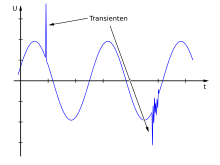Transient
A transient is a settling process or a section in a signal that heralds such an unsteady process, see also step and impulse response . Transients are often very short on electrical lines or in electronic circuits.
definition
The term transient comes from Latin and means "transition". For example, a damped oscillator needs some time to regain equilibrium after a brief disturbance or after a permanent change in a system variable has occurred to reach the new equilibrium.
Transient voltages (processes) cannot be foreseen in time (random) and are of limited duration. They do not repeat themselves periodically and their form cannot be clearly predicted.
Terms
Other terms that have to do with transients:
- Transient Recovery Voltage
- Transient recovery time
Time it takes for the output voltage of a power supply to stabilize within the limit values after transients have occurred.
- Transient Response Time
Time interval between the occurrence of transients and the return to a specified amplitude range .
- Transient response
Transient behavior of a circuit in response to a sudden change at the input or output.
- Transient
Deviation of a certain parameter, generally the input voltage or the load at the output.
Areas where the transients matter
Audio
The term transient (m), sometimes also transient (f), describes the short period of time in which an oscillating system suddenly set into oscillation (string, column of air, rod, etc.) initially oscillates chaotically (noise) before the Arrange longitudinal waves in fundamental and harmonic harmonics (sound).
Among other things, on the basis of the specific transient character, we reliably differentiate and identify natural sounds, e.g. B. the bow painting of a string , or the approach of a speaking voice known to us.
power grid
The reliable detection of transient processes in the electrical power supply network is very important in order to avoid damage. Constant changes in the electrical supply network due to switching operations and faults result in new network states that the overall system must adapt to (see also voltage regulation ). Normally, transient equalizing currents and equalizing voltages occur. In order to be able to assess whether the transient processes result from an intentional or unwanted network change, one needs reliable decision criteria. When examining the steady-state and transient behavior as well as when analyzing and planning energy supply networks, the interference immunity against fast electrical transients (bursts) and impulse packets must be considered.
Device power supplies
In hardware circuits, transients are used to describe voltage peaks which can occur in connection with power supplies and which may damage the circuit. In power supply units, a large load change due to the necessary adjustment processes leads to a settling in the output voltage. Small fluctuations are therefore a quality feature, or poor power supplies can lead to malfunctions in the connected electronics.
Exactly defined transients (standard lightning strikes ) are test parameters when checking the electromagnetic compatibility of devices. A distinction is made between high-energy transient interference pulses (impulse voltages, surge) and fast transient interference pulses (burst). The technical measures of the overvoltage protection serve to protect against transients caused by lightning and other causes.
See also
literature
- Magnús Pétursson, Joachim MH Neppert: Elementary Book of Phonetics. Buske, 2002
- Bernd R. Oswald: Calculation of three-phase networks. Vieweg + Teubner, 2009
Individual evidence
- ^ From: Juan G. Roederer: "Physical and psychoacoustic foundations of music", Springer-Verlag, Berlin, 1975.

